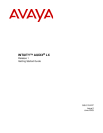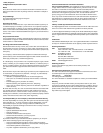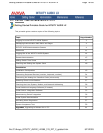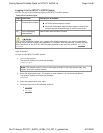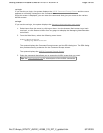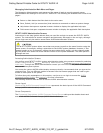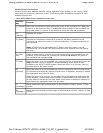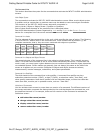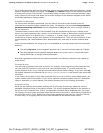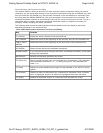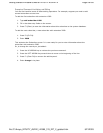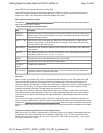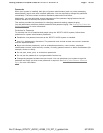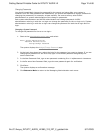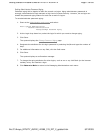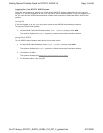2003, Avaya Inc.
All Rights Reserved, Printed in U.S.A.
Notice
Every effort was made to ensure that the information in this book was com-
plete and accurate at the time of printing. However, information is subject to
change.
Avaya Web Page
The world wide web home page for Avaya is:
http://www.avaya.com
Preventing Toll Fraud
Toll Fraud is the unauthorized use of your telecommunications system by an
unauthorized party (for example, a person who is not a corporate employee,
agent, subcontractor, or working on your company’s behalf). Be aware that
there is a risk of toll fraud associated with your system and that, if toll fraud
occurs, it can result in substantial additional charges for your telecommunica-
tions services.
Avaya Fraud Intervention
If you suspect that you are being victimized by toll fraud and you need techni-
cal assistance or support, call the Technical Service Center’s Toll Fraud Inter-
vention Hotline at 1.800.643.2353.
Providing Telecommunications Security
Telecommunications security of voice, data, and/or video communications is
the prevention of any type of intrusion to, that is, either unauthorized or mali-
cious access to or use of, your company’s telecommunications equipment by
some party.
Your company’s “telecommunications equipment” includes both this Avaya
product and any other voice/data/video equipment that could be accessed via
this Avaya product (that is, “networked equipment”).
An “outside party” is anyone who is not a corporate employee, agent, subcon-
tractor, or working on your company’s behalf. Whereas, a “malicious party” is
Anyone, including someone who may be otherwise authorized, who accesses
your telecommunications equipment with either malicious or mischievous
intent.
Such intrusions may be either to/through synchronous (time-multiplexed and/
or circuit-based) or asynchronous (character-, message-, or packet-based)
equipment or interfaces for reasons of:
• Utilization (of capabilities special to the accessed equipment)
• Theft (such as, of intellectual property, financial assets, or toll-facility
access)
• Eavesdropping (privacy invasions to humans)
• Mischief (troubling, but apparently innocuous, tampering)
• Harm (such as harmful tampering, data loss or alteration, regardless of
motive or intent)
Be aware that there may be a risk of unauthorized intrusions associated with
your system and/or its networked equipment. Also realize that, if such an
intrusion should occur, it could result in a variety of losses to your company,
including but not limited to, human/data privacy, intellectual property, material
assets, financial resources, labor costs, and/or legal costs).
Your Responsibility for Your Company’s Telecommunications Security
The final responsibility for securing both this system and its networked equip-
ment rests with you – an Avaya customer’s system administrator, your tele-
communications peers, and your managers. Base the fulfillment of your
responsibility on acquired knowledge and resources from a variety of sources
including but not limited to:
• Installation documents
• System administration documents
• Security documents
• Hardware-/software-based security tools
• Shared information between you and your peers
• Telecommunications security experts
To prevent intrusions to your telecommunications equipment, you and your
peers should carefully program and configure your:
• Avaya provided telecommunications systems and their interfaces
• Avaya provided software applications, as well as their underlying hard-
ware/software platforms and interfaces
• Any other equipment networked to your Avaya products
Federal Communications Commission Statement
Part 15: Class A Statement. This equipment has been tested and found to
comply with the limits for a Class A digital device, pursuant to Part 15 of the
FCC Rules. These limits are designed to provide reasonable protection
against harmful interference when the equipment is operated in a commercial
environment. This equipment generates, uses, and can radiate radio-fre-
quency energy and, if not installed and used in accordance with the instruc-
tions, may cause harmful interference to radio communications. Operation of
this equipment in a residential area is likely to cause harmful interference, in
which case the user will be required to correct the interference at his own
expense.
Industry Canada (IC) Interference Information
This digital apparatus does not exceed the Class A limits for radio noise emis-
sions set out in the radio interference regulations of Industry Canada.
Le Présent Appareil Nomérique n’émet pas de bruits radioélectriques dépas-
sant les limites applicables aux appareils numériques de la class A préscrites
dans le reglement sur le brouillage radioélectrique édicté par le Industrie Can-
ada.
Trademarks
All trademarks identified by ® and ™ are registered trademarks or trademarks
of Avaya Inc. All other trademarks are the property of their respective owners.
Ordering Information
Call: Avaya Publications Center
Voice 1 800 457-1235 International Voice +1 207 866 6701
Fax 1 800 457-1764 International Fax +1 207 626 7269
Write: GlobalWare Solutions
200 Ward Hill Avenue
Haverhill, MA 01835 USA
Attn: Avaya Account Management
Email: totalware@gwsmail.com
Obtaining Products
To learn more about Avaya products and to order products, visit
www.avaya.com.
European Union Declaration of Conformity
The “CE” mark affixed to the equipment means that it conforms to the refer-
enced European Union (EU) Directives listed below:
EMC Directive 89/336/EEC
Low-Voltage Directive73/23/EEC
For more information on standards compliance, contact your local distributor.
Warranty
Avaya Inc. provides a limited warranty on this product. Refer to your sales
agreement to establish the terms of the limited warranty. In addition, Avaya’s
standard warranty language as well as information regarding support for this
product, while under warranty, is available through the following web site:
http://www.avaya.com/support.



